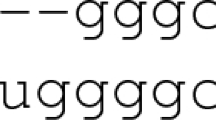Abstract
A molecular sequence “model” is a (structured) sequence of distinct or identical strings separated by gaps; here we design and analyze efficient algorithms for variations of the “Model Matching” and “Model Identification” problems.
Partially supported by Royal Society, Wellcome and NATO grants
C. Makris was partially supported by a Royal Society grant
Partially supported by a Royal Society grant
Access this chapter
Tax calculation will be finalised at checkout
Purchases are for personal use only
Preview
Unable to display preview. Download preview PDF.
Similar content being viewed by others
References
A. Apostolico and Z. Galil. Pattern Matching Algorithms. Oxford University Press, ISBN 0-19-611367-5, 1997.
G. S. Brodal, R. B. Lyngs, C. N. Storm Pedersen and DKFZ Jens Stoye. Finding Maximal Pairs with Bounded Gaps. Journal of Discrete Algorithms, 0(0):1–27, 2000.
M. R. Brown and R. E. Tarjan. A Fast Merging Algorithm. Journal of the ACM, 26(2):211–226, 1979.
M. R. Brown and R. E. Tarjan. Design and Analysis of a Data Structure for Rep-resenting Sorted Lists. SIAM Journal on Computing, 9:594–614, 1980.
D. Gusfield. Algorithms on Strings, Trees, and Sequences. Cambridge University Press, ISBN 0-521-58519-8, 1999.
G. Navarro. A Guided Tour to Approximate String Matching. ACM Computing Surveys, 33(1):31–88, 2001.
G. A. Stephen. String Searching Algorithms. Lecture Notes Series on Computing-Vol. 3, World Scientific Publishing, ISBN 981-02-1829-X, 1994.
E. Ukkonen. Finding Approximate atterns in strings. Journal of Algorithms, 6:132–137, 1985.
Author information
Authors and Affiliations
Editor information
Editors and Affiliations
Rights and permissions
Copyright information
© 2002 Springer-Verlag Berlin Heidelberg
About this paper
Cite this paper
Iliopoulos, C.S., Makris, C., Sioutas, S., Tsakalidis, A., Tsichlas, K. (2002). Identifying Occurrences of Maximal Pairs in Multiple Strings. In: Apostolico, A., Takeda, M. (eds) Combinatorial Pattern Matching. CPM 2002. Lecture Notes in Computer Science, vol 2373. Springer, Berlin, Heidelberg. https://doi.org/10.1007/3-540-45452-7_12
Download citation
DOI: https://doi.org/10.1007/3-540-45452-7_12
Published:
Publisher Name: Springer, Berlin, Heidelberg
Print ISBN: 978-3-540-43862-5
Online ISBN: 978-3-540-45452-6
eBook Packages: Springer Book Archive




